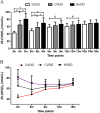Effects of vitamin D supplementation on serum 25(OH)D3 levels and neurobehavioral development in premature infants after birth
- PMID: 39397102
- PMCID: PMC11471846
- DOI: 10.1038/s41598-024-75191-w
Effects of vitamin D supplementation on serum 25(OH)D3 levels and neurobehavioral development in premature infants after birth
Abstract
This study explored the factors influencing serum 25(OH)D3 levels and the effects of Vitamin D deficiency (VDD) and VD supplementation on 25(OH)D3 levels and neuropsychobehavioral development in premature infants, to provide a theoretical basis for improving their prognosis. Physical examination, neuropsychobehavioral development and serum 25(OH)D3 levels were assessed regularly in 158 preterm infants supplemented with VD formulation. 25(OH)D3 levels were analyzed at 3, 6, 9, 12, and 18 months after birth. The Gesell neuropsychological development test was conducted at 6, 9, 12, and 18 months after birth to obtain the developmental quotient (DQ). Based on the serum 25(OH)D3 levels at 42 days of age, the infants were divided into VDD and non-VDD groups. Preterm infants in the VDD group were supplemented with more VD until their 25(OH)D3 levels were normal, and were divided into sustained VDD (SVDD) and corrected VDD (CVDD) groups according to serum 25(OH)D3 levels at 3 months of age. Appropriate statistical methods were chosen to compare differences in 25(OH)D3 and DQ between or among different groups, screen for the factors influencing 25(OH)D3 levels in preterm infants at 42 days of age, and analyze the relationship between 25(OH)D3 and DQ. The 25(OH)D3 levels of preterm infants at 42 days of age were positively correlated with VD supplementation during pregnancy, and before 42 days after birth (P < 0.05). The 25(OH)D3 levels in preterm infants at 42 days and 3 months of age were positively correlated with the DQ levels at 6, 9, 12, and 18 months of age (P < 0.05). The DQ level in the VDD group, especially SVDD group, was lower than that in CVDD and non-VDD groups at the same time point (P < 0.05). This research thus demonstrates that VD supplementations during pregnancy and after birth is a major factor affecting 25(OH)D3 levels in premature infants. Early VDD and SVDD can affect their neuropsychobehavioral development, and effective VD supplementation can gradually correct VDD and mitigate this influence.
Keywords: 25(OH)D3; Neuropsychobehavioral development; Premature infants; Vitamin D; Vitamin D deficiency.
© 2024. The Author(s).
Conflict of interest statement
The authors declare no competing interests.
Figures





Similar articles
-
[Vitamin D level in umbilical cord blood of late preterm infants and the effect of vitamin D3 supplementation on the behavioral development of infants and young children: a prospective randomized controlled study].Zhongguo Dang Dai Er Ke Za Zhi. 2022 Nov 15;24(11):1189-1194. doi: 10.7499/j.issn.1008-8830.2206096. Zhongguo Dang Dai Er Ke Za Zhi. 2022. PMID: 36398542 Free PMC article. Clinical Trial. Chinese.
-
Evaluation of vitamin D prophylaxis in 3-36-month-old infants and children.J Pediatr Endocrinol Metab. 2017 May 1;30(5):543-549. doi: 10.1515/jpem-2016-0223. J Pediatr Endocrinol Metab. 2017. PMID: 28328529
-
Randomized controlled trial of enteral vitamin D supplementation (ViDES) in infants <28 weeks gestational age or <1000 g birth weight: study protocol.Trials. 2024 Jun 28;25(1):423. doi: 10.1186/s13063-024-08274-8. Trials. 2024. PMID: 38943179 Free PMC article.
-
Reassessing vitamin D supplementation in preterm infants: a prospective study and review of the literature.J Pediatr Endocrinol Metab. 2020 Aug 31;33(10):1273-1281. doi: 10.1515/jpem-2020-0370. J Pediatr Endocrinol Metab. 2020. PMID: 32866125 Review.
-
25(OH)D3-enriched or fortified foods are more efficient at tackling inadequate vitamin D status than vitamin D3.Proc Nutr Soc. 2018 Aug;77(3):282-291. doi: 10.1017/S0029665117004062. Epub 2017 Nov 27. Proc Nutr Soc. 2018. PMID: 29173203 Free PMC article. Review.
Cited by
-
Vitamin D-related risk factors for preterm and full-term infants at birth: a retrospective study.BMC Pediatr. 2025 May 24;25(1):417. doi: 10.1186/s12887-025-05765-8. BMC Pediatr. 2025. PMID: 40413415 Free PMC article.
-
Vitamin D: What We Know and What We Still Do Not Know About Vitamin D in Preterm Infants-A Literature Review.Children (Basel). 2025 Mar 20;12(3):392. doi: 10.3390/children12030392. Children (Basel). 2025. PMID: 40150674 Free PMC article. Review.
References
-
- Walani, S. R. Global burden of preterm birth. Int. J. Gynaecol. Obstet.150, 31–33 (2020). - PubMed
-
- Cashman, K. D., Vitamin, D. & Deficiency Defining, Prevalence, causes, and strategies of addressing. Calcif Tissue Int.106, 14–29 (2020). - PubMed
-
- Weiler, H. A., Yuen, C. K. & Seshia, M. M. Growth and bone mineralization of young adults weighing less than 1500 g at birth. Early Hum. Dev.67, 101–112 (2002). - PubMed
MeSH terms
Substances
LinkOut - more resources
Full Text Sources
Medical

